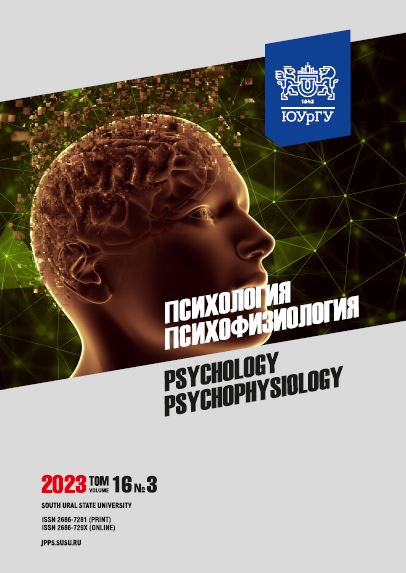The “Disgust scale”: adaptation of the Russian-language version on a Russian sample of female students
Abstract
Introduction. Currently, the studies of biopsychosocial mechanisms of the induction of affective states, their role in psychological defense, as well as the global problems of prophylaxis of personality disorders, psychosomatic disorders, and victimhood are of particular relevance. Russian psychologists point out a deficit of diagnostic tools to identify sensitivity and tolerance to affective stimuli, including those of endogenous nature. Aim: to adapt the Disgust Scale-Revised on a Russian sample of female students. Materials and methods. Psychometric results were obtained on the data of a heterogeneous sample of 375 female university students with a mean age of 19.71 years, SD = 1.39. Internal consistency and retest reliability were evaluated by the Cronbach’s alpha test, the Pearson correlation test, and the Students’ t test for paired data. Test validity was determined by comparing the test results with the frequency of behavioral responses caused by exposure to an affective stimulus that induced disgust. Results. The values of the integral indicator and subscales are considered normal with respect to the Kolmogorov-Smirnov test. Data normalization was performed using centile analysis, where less than 1.73 c.u. was tolerant to disgust and more than 2.48 c.u. was sensitive to disgust. The internal consistency of the test was considered “good” with a Cronbach’s alpha of 0.87. Satisfactory results of retest reliability were obtained on a dependent sample (n = 367) a year after the first test. The validity of the Disgust Scale-Revised was assessed by comparing the test data and the results of the frequency analysis of behavioral responses to affective stimuli. It was shown that people sensitive to disgust were significantly more likely to demonstrate behavioral responses in all patterns. Conclusion. The results obtained from a Russian sample of female students demonstrate that this diagnostic tool is reliable and valid for the assessment of sensitivity to disgust.
Downloads
References
2. Olatunji B.O., Williams N.L., Tolin D.F. et al. The Disgust Scale: item analysis, factor structure, and suggestions for refinement. Psychological Assessment. 2007;19(3):281–297. DOI: https://doi.org/10.1037/1040-3590.19.3.281
3. Verdi E.K., Quach C., Singh N.B. et al. Disgust uniquely predicts coping and interpersonal processes beyond anxiety and dysphoria in the context of naturalistic stressors. Journal of Anxiety Disorders. 2021;82:102446. DOI: https://doi.org/10.1016/j.janxdis.2021.102446.
4. Curtis V., Barra M. de, Aunger R. Disgust as an adaptive system for disease avoidance behavior. Philosophical Transactions of the Royal Society B. 2011;366(1563):389–401. DOI: https://doi.org/10.1098/rstb.2010.0117
5. Grauvogl A., de Jong P., Peters M. et al. Disgust and sexual arousal in young adult men and women. Archives of Sexual Behavior. 2015;44(6):1515–1525.
6. Skolnick A.J., Dzokoto V.A. Disgust and contamination: a cross-national comparison of Ghana and the United States. Frontiers in Psychology. 2013;4:91. DOI: https://doi.org/10.3389/fpsyg.2013.00091
7. An S., Ji LJ, Marks M., Zhang Z. Two sides of emotion: exploring positivity and negativity in six basic emotions across cultures. Frontiers in Psychology. 2017;8:610. DOI: https://doi.org/10.3389/fpsyg.2017.00610
8. Giampietro M., Ruggi S., Caravita S.C.S. et al. A measure to assess individual differences for disgust sensitivity: an Italian version of the Disgust Scale – Revised. Current Psychology. 2019;38:354–366. DOI: https://doi.org/10.1007/s12144-017-9604-x
9. Siegrist M., Bearth A., Hartmann C. Food disgust sensitivity influences the perception of food hazards: Results from longitudinal and cross-cultural studies. Appetite. 2020;53:104742. DOI: https://doi.org/10.1016/j.appet.2020.104742
10. Rottman J., Young L. Specks of dirt and tons of pain: Dosage distinguishes impurity from harm. Psychological Science. 2019;30(8):1151–1160. DOI: https://doi.org/10.1177/0956797619855382
11. Jones A., Fitness J. Moral hypervigilance: the influence of disgust sensitivity in the moral domain. Emotion. 2008;8(5):613–627. DOI: https://doi.org/10.1037/a0013435
12. Troisi A. Fear of Covid-19: Insights from evolutionary behavioral science. Clinical Neuropsychiatry. 2020;17(2):72–75. DOI: https://doi.org/10.36131/CN20200207
13. Inbar Y., Pizarro D.A. How disgust affects social judgments – Chapter Three. Advances in Experimental Social Psychology. Ed. B. Gawronsk. Academic Press. 2022;65:109–166. DOI: https://doi.org/10.1016/bs.aesp.2021.11.002.
14. Tybur J.M., Bryan A.D., Lieberman D. et al. Sex differences and sex similarities in disgust sensitivity. Personality and Individual Differences. 2011;51(3):343–348. DOI: https://doi.org/ 10.1016/j.paid.2011.04.003
15. Skolnick A.J. Gender differences when touching something gross: unpleasant? No. Disgusting? Yes! The Journal of General Psychology. 2013;140 (2):144–157. DOI: https://doi.org/10.1080/ 00221309.2013.781989
16. Polák J., Landová E., Frynta D. Undisguised disgust: a psychometric evaluation of a disgust propensity measure. Current Psychology. 2019;38:608–617. DOI: https://doi.org/10.1007/s12144-018-9925-4
17. Widen S.C., Russell J.A. Childrens recognition of disgust in others. Psychological Bulletin. 2013;139(2):271–299. DOI: https://doi.org/10.1037/a0031640.
18. Oosterwijk TAT, Borg CC, van Dijk MWGM. Age-related differences in self-reported disgust toward core disgust, sex-related, and food stimuli. Journal of Adolescence. 2022;94(3):293–304. DOI: https://doi.org/10.1002/jad.12013
19. Haidt J., McCauley C., Rozin P. Individual differences in sensitivity to disgust: A scale sampling seven domains of disgust elicitors. Personality and Individual Differences. 1994;16:701–713.
20. Kang J.I., Kim S.J., Cho H.J. et al. Psychometric analysis of the Korean version of the Disgust Scale-Revised. Comprehensive Psychiatry. 2012;53(5):648–655. DOI: https://doi.org/10.1016/ j.comppsych.2011.06.005
21. Kim E.H., Ebesutani C., Young J., Olatunji B.O. Factor structure of the disgust scale-revised in an adolescent sample. Assessment. 2013;20(5):620–631. DOI: https://doi.org/10.1177/1073191111434200
22. Pehlivanidis A., Pehlivanidi N., Papanikolaou K. et al. The Emotion of Disgust among Medical and Psychology Students. Diseases. 2020;8(4):43. DOI: https://doi.org/10.3390/diseases8040043
23. Olatunji B.O., Williams N.L., Lohr J.M., Sawchuk C.N. The structure of disgust: domain specificity in relation to contamination ideation and excessive washing. Behaviour Research and Therapy. 2005;43(8):1069–1086. DOI: https://doi.org/10.1016/j.brat.2004.08.002.
24. Overveld M., de Jong P.J., Peters M.L., Schouten E. The Disgust Scale-R: A valid and reliable index to investigate separate disgust domains? Personality and Individual Differences. 2011;51(3):325–330. DOI: https://doi.org/10.1016/j.paid.2011.03.023.
25. Ilyin E.P. Emotsii i chuvstva [Emotions and feelings]. St. Petersburg: Piter. 2019:784. (in Russ.).
26. Baiguzhin P.A., Shibkova D.Z., Kudryashov A.A., Baiguzhina O.V. Reactivity of the Vegetative Nervous System Influenced by Non-Verbal Information. Human. Sport. Medicine. 2019;19(S1):83–93. (in Russ.) DOI: https://doi.org/10.14529/hsm19s111
27. Siddiqui H., Shahzad H.F., Saleem A.A. et al. Respiration based non-invasive approach for emotion recognition using impulse radio ultra wide band radar and machine learning. Sensors. 2021;21(24):8336. DOI: https://doi.org/10.3390/s21248336
References on translit
-Copyright (c) 2023 Psychology. Psychophysiology

This work is licensed under a Creative Commons Attribution-NonCommercial-NoDerivatives 4.0 International License.



